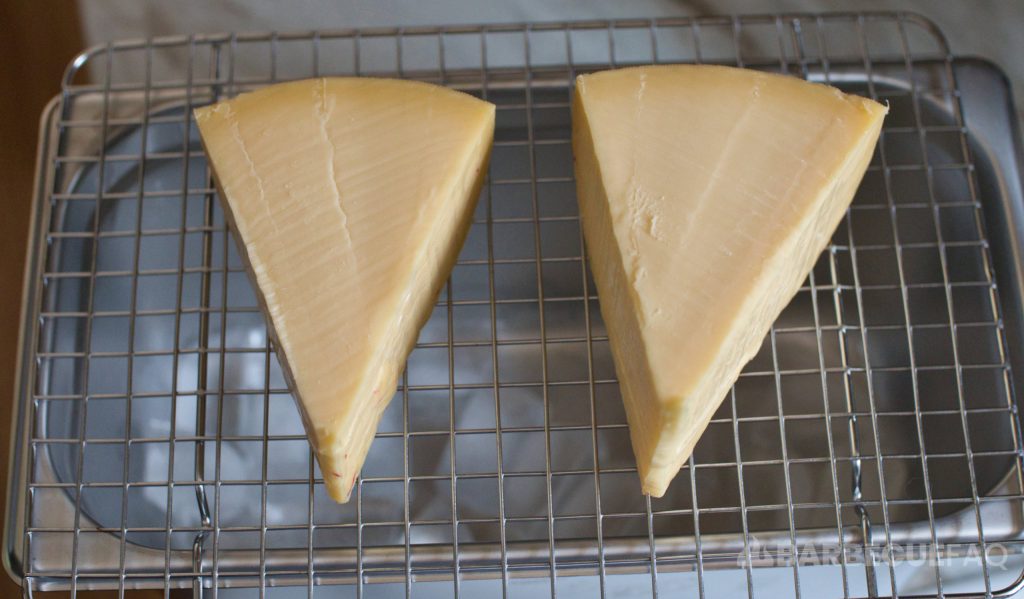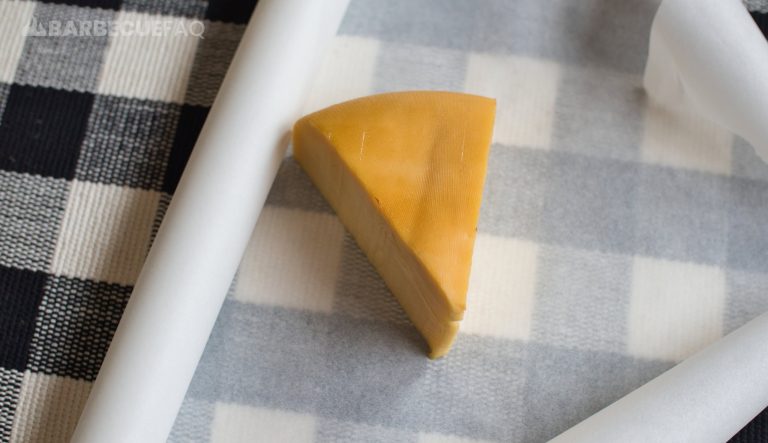Setting Up Your Smoker to Cold Smoke
You will need:
- Wire rack
- A pellet tube or “maze”
Optionally: A pan that you can fill with ice (like aluminum pans).
If The Outdoor Temperature is Greater than 40F
Use the aluminum pans and load them with a good amount of ice.
The goal of the ice pans is to help keep the ambient temperature down in your smoker as much as possible.
Meaning, if it’s winter where you live, skip this step. Most people who smoke cheese do so in the winter for this reason alone.
Place your Gouda Cheese on top of a wire rack and then place that on top of the ice pan.
Then follow the steps below.

If the Outdoor Temperature is Below 40F
Place your Gouda cheese on top of a cooling rack and then place that in your smoker.
Use either fine saw dust or pellets (I use maple or alder with cheese) and fill your cold smoking device. For this recipe, I used my A-MAZE-N smoker maze.
Use a butane torch and light both ends for around 30-45 seconds.

You’ll likely notice a small flame emerge, allow this to burn for around 10 minutes. After 10 minutes, blow the flame out and allow it to continue smoldering/smoking.
Place your cold smoking device in your smoker so that it’s below the cheese.

Allow the cheese to cold smoke for 30 minutes to 1 hour.
After smoking, take the Gouda out of your smoker and then wrap in parchment paper. Place in your refrigerator for 48 hours.

After 48 hours, vacuum seal the cheese and then place in your refrigerator for 2-4 weeks.

The reason for the parchment paper and vacuum sealing is to help aerate the cheese and to help temper the “cold smoke” flavor which can be quite bitter at first.
Over the course of the 2 weeks it will mellow out in the vacuum seal.
Help! My Cheese Melted or is Sweating
If you’re struggling to keep your cheese from melting or “sweating” it’s because your smoker is too hot, you need to use:
The reason the cheese is melting has to do with the melting point of the butterfat – which is around 90-95F.
Most smokers can’t smoke at temperatures below 160F. Even my Masterbuilt electric smoker can only go as low as 110F.
The result is either the cheese melting or “sweating.”
Homemade Cold Smoked Gouda Cheese
Ingredients
- 1 Block Gouda Cheese
Instructions
If It's Hotter than 40F Outside – Use an Aluminum Pan
- Fill an aluminum pan with ice.
- Place a wire rack above the pan.
- Place Gouda Cheese on the wire rack.
- Then proceed to the next section.
If It's Colder than 40F Outside
- Setup your cold smoking device. I used an A-MAZE-N smoker maze with maple sawdust.
- Once the device is lit, allow it to burn for around 10 minutes. You may notice a slight flame – blow it out after 10 minutes and the device should be smoldering your wood.
- Place the device in your smoker.
- Then place your cheese above the cold smoking device.
- Allow the cheese to smoke for 30 minutes to 1 hour.
Wrap in Parchment Paper
- After cold smoking, wrap the cheese in parchment paper and then place in your refrigerator for 48 hours. This step allows the cheese to aerate.
Vacuum Seal for 14 Days
- After 48 hours, vacuum seal and then place back in your refrigerator for 14 days. This step allows the bitter cold smoking flavor to temper and improves flavor.
- After 14 days, open the vacuum seal and enjoy your cheese!





